Koss SB45 headset adapters for some amateur radio & GMRS transceivers
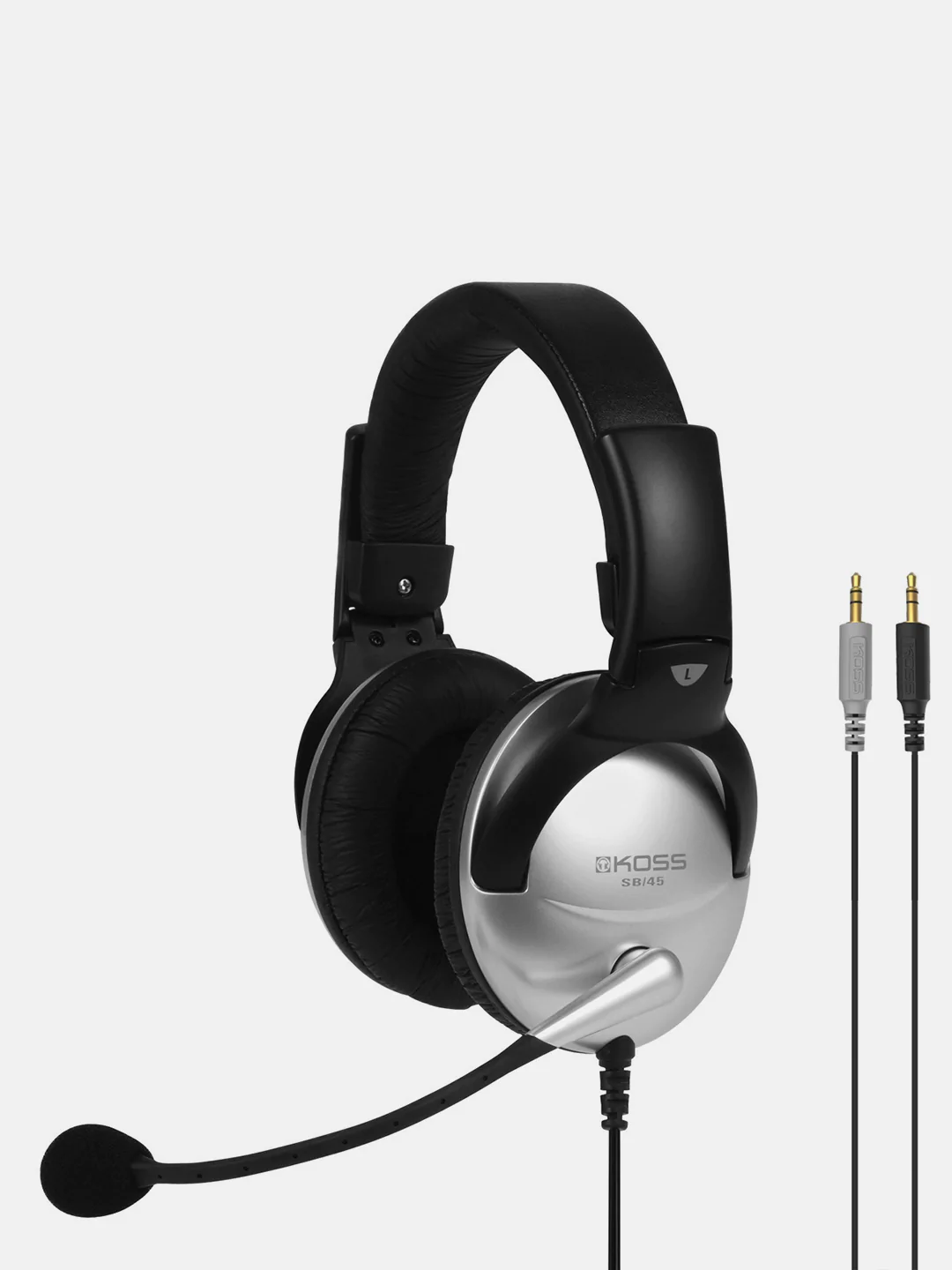
At about $30, the Koss SB45 is a well-regarded headset for amateur radio use. It has an electret microphone element, which is compatible with many handheld transceivers. (For those transceivers which expect a dynamic microphone, for example some Yaesu models, the Koss SB40 is a similar model in appearance, price range, and in good reviews received.)
| Koss SB45 | |
|---|---|
| Microphone | Electret |
| Impedance | 100Ω |
| Sound Output | 103dB SPL / 1mW |
| Mic Sensitivity | -36dB ± 3dB, V/Pa (more sensitive) |
| DC Power Required | Yes |
| Koss SB40 | |
|---|---|
| Microphone | Dynamic |
| Impedance | 120Ω |
| Sound Output | 96 dB SPL / 1mW |
| Mic Sensitivity | -56dB ± 3dB, V/Pa (less sensitive) |
| DC Power Required | No |
The headsets do not simply plug in to the radios, however. In this post I describe some adapters I made to use the Koss SB45 headset with a few different radios.
Each adapter includes a push-to-talk (PTT) button, a toggle switch to lock PTT on, and a 1/4" phone jack for a foot pedal or hand-held PTT button.
Adapter for Wouxon KG-805G
The Wouxon KG-805G is a handheld GMRS transceiver.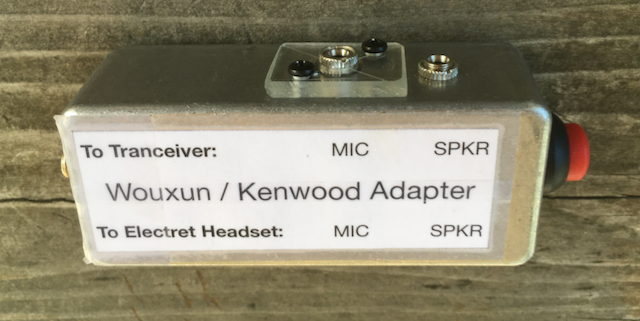
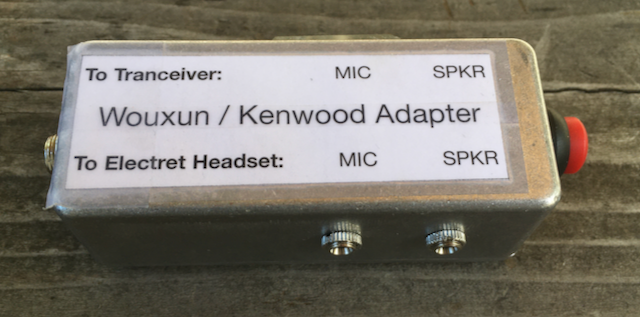
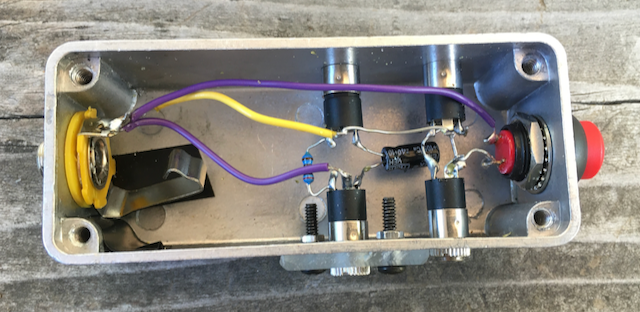
From observing the availability of speaker microphones that are compatible with both Kenwood and Wouxun handhelds (e.g., like this), I looked for documentation for adapting headsets to the “Kenwood standard.”.
Kenwood speaker/mics have the following pinout:
| 2.5mm Speaker Jack | |
|---|---|
| Tip | Speaker |
| Ring | Program |
| Shield | Ground |
| 3.5mm Microphone Jack | |
|---|---|
| Tip | 5V |
| Ring | Mic+ |
| Shield | PTT |
N1GY has a nice article, A Headset Adaptor for Kenwood, Baofeng and Wouxun HTs, describing such an adapter. That adapter shown there specifies shorting the program connection to ground. I found when I did that, however, that the transmit LED on the KG-805G glowed dimly. That didn't seem right, so I opted to just leave the Program line disconnected. Here is the schematic that I used in the end.
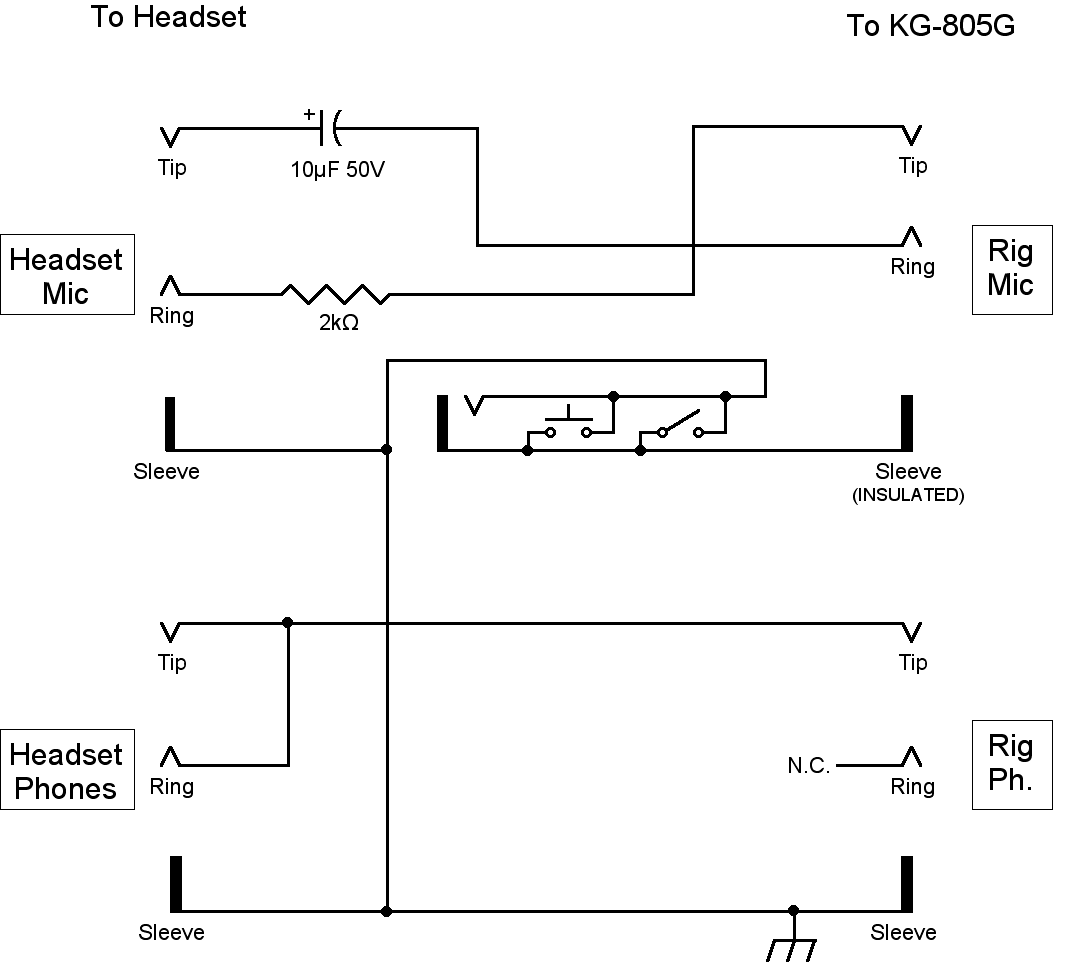
Note that the shield of the Mic line to the KG-805G is not grounded! Grounding that shield is the way that PTT is actuated. I used a piece of acrylic plastic to mount the jack for this connection, to avoid it being grounded through the metal project box.
Adapter for Alinco DJ-500T
The Alinco DJ-500 is a handheld 2 Meter / 440 MHz transceiver.
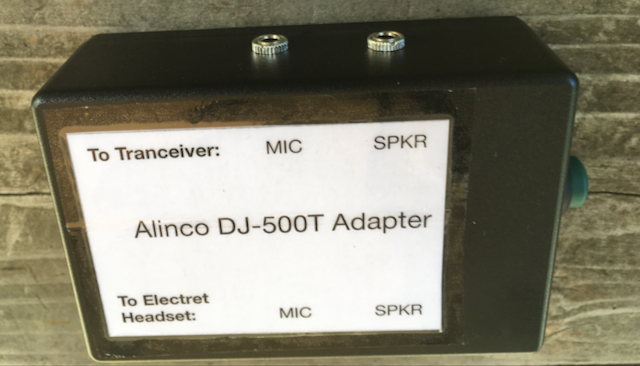
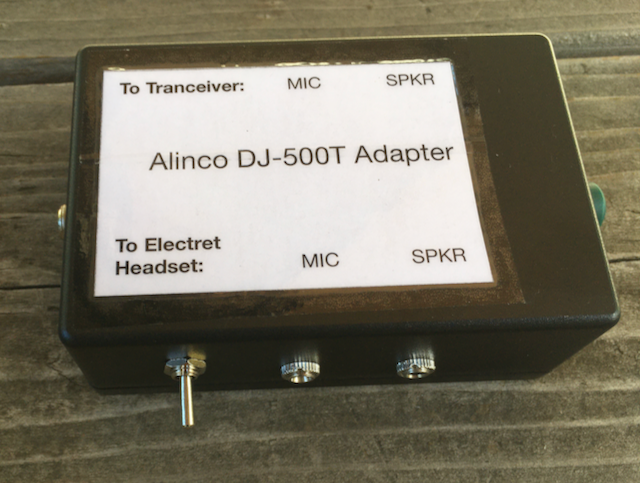

Some digging produced a pinout for the DJ-500t.
| 3.5mm Speaker Jack | |
|---|---|
| Tip | Speaker+ |
| Ring | n/c |
| Shield | Speaker- |
| 2.5mm Microphone Jack | |
|---|---|
| Tip | Mic+ |
| Ring | 5V |
| Shield | Ground |
The DJ-500T handheld is compatible with the Alinco EMS-76 Speaker/Mic and EME-56A Earphone Mic. I was able to get a look at the circuit diagram for the EME-56A (no link available), and based the following similar circuit on that.
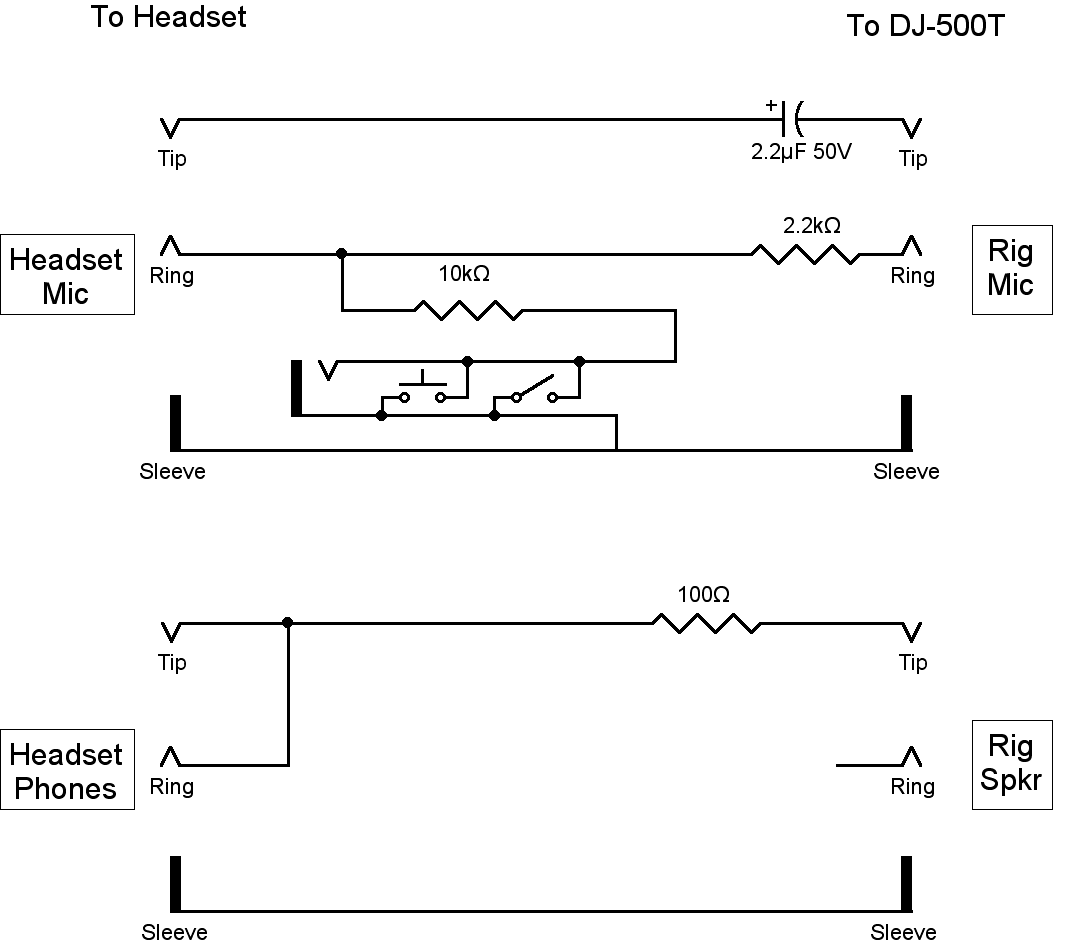
Adapter for Alinco DR-590T
The Alinco DR-590T is a much older and discontinued 2 meter / 440 MHz mobile transceiver.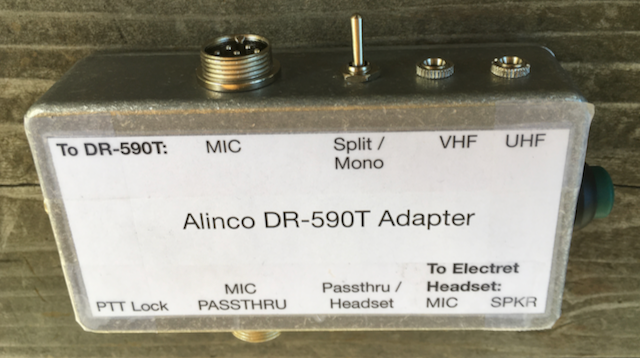
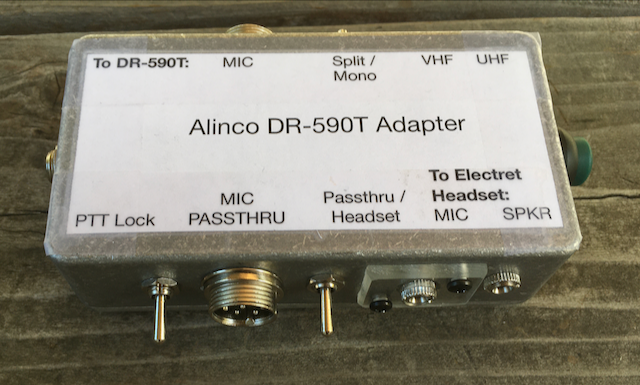
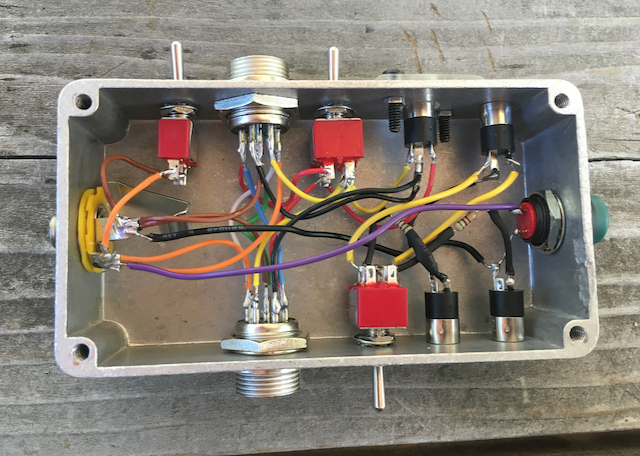
The pinout for the DR-590 microphone jack is available from the schematic in the service manual, available here. Similar information is available here.
| Alinco Mobile Microphone Jack | |
|---|---|
| 1 | Mic Input |
| 2 | PTT |
| 3 | Down |
| 4 | Up |
| 5 | +5 VDC |
| 6 | DTMF |
| 7 | Mic Ground & Shield |
| 8 | Ground |
The DR-590T comes with a speaker/mic with a DTMF keyboard, so I thought I might want to switch easily back and forth between the headset and the speaker/mic. I added a toggle switch for that. The rig also has separate speaker jacks for VHF and UHF; I included a switch to choose between combining both outputs and sending the result to both earpieces, or feeding VHF to one earpiece and UHF to the other.
I cribbed most of the adapter circuit from the EMS-52 Service manual. The VHF and UHF outputs are too high for safe headphone use, so I tried out various resistances to drop the outputs to a reasonable level. I did not want to adjust the internal mic gain pot for different mics, so the 47kΩ resistor in the mic line was also chosen by experimentation, to give an audio level close to that produced by the speaker mic.

Notes
- The Koss SB45 has the ring and tip of the microphone connector tied together (0Ω resistance), presumably to accomodate different sound card conventions; different headphones might require paying attention to what is connected to what.
- For testing, it was convenient to run the adapted rig on low power with a dummy load attached while listening through headphones to a nearby (e.g. a few feet away) receiver with a minimal antenna. This produces enough signal to get a good handle on quality and audio level without messing up the airwaves.
- Different color audio cables are helpful in avoiding mistakes in hooking up the adapter to the rig. (I adopted the custom of always using a red cable for the mic; this matches the convention on many computer connectors where red is for mic and green is for phones.)
- Purchasing a short 3.5mm to 2.5mm adapter cable (e.g., this) allows for standardizing on 3.5mm audio cables and jacks everywhere else.
References
- Computer Microphones
- What's the pinout for "Kenwood" 2.5mm TRS/3.5 mm TRS connector?
- Extensive archive of microphone connections
- Connector Chart
- Electret microphone instead of dynamic and vice versa
- Gaming headset 3.5mm TRS mic plug pinout
To contact the author, send email.